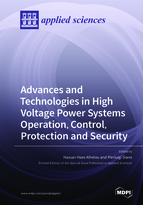Advances and Technologies in High Voltage Power Systems Operation, Control, Protection and Security
A special issue of Applied Sciences (ISSN 2076-3417). This special issue belongs to the section "Energy Science and Technology".
Deadline for manuscript submissions: closed (30 June 2020) | Viewed by 39460
Special Issue Editors
Interests: smart grids; energy management; power systems; demand response
Special Issues, Collections and Topics in MDPI journals
Interests: smart grids; power system control; power system dynamics and stability
Special Issues, Collections and Topics in MDPI journals
Special Issue Information
Dear Colleagues,
We would like to invite submissions to a Special Issue of Applied Sciences on the subject of high and extra-high voltage systems entitled “Advances and Technologies in High-Voltage Power Systems Operation, Control, Protection and Security”. The electrical demands in several countries around the world are increasing due to the huge energy requirements of prosperous economies and the human activities of modern life. In order to economically transfer electrical powers from generation-side to demand-side, these powers need to be transferred at high-voltage levels through suitable transmission systems and power substations. To this end, high-voltage transmission systems and power substations are in demand. Actually, they are at the heart of interconnected power systems, in which any faults might lead to unsuitable consequences, abnormal operation situations, security issues, and even power cuts and blackouts. In order to cope with the ever-increasing operation and control complexity and security in interconnected high-voltage power systems, new architectures, concepts, algorithms, and procedures are essential. This Special Issue aims at encouraging researchers to address the technical issues and research gaps in high-voltage transmission systems and power substations in modern energy systems. The topics of interest of this Special Issue include but are not limited to the following:
- Power system protection and security;
- High-voltage systems dynamics and stability;
- High-voltage transmission/power-station systems operation and control;
- Issues in extra high-voltage systems;
- High-voltage transmission lines and tie-lines;
- High-voltage power station automation and control;
- High-voltage power system monitoring, and security;
- Technical issues in high-voltage transmission systems;
- Border links between high-voltage systems and other voltage levels;
- Power station/substation architecture;
- Artificial Intelligence applications to high-voltage power systems;
- Energy trading in transmission systems;
- Systems of systems at high-voltage levels;
- Methodologies and applications of modern methods for the power substations and transmission systems;
- System reliability, sustainability, flexibility, and resiliency;
- The design, modeling, and management of interconnected and bulk power systems;
- Lighting protection in power systems;
- Voltage surges in power systems;
- Isolation issues at high-voltage levels;
- Frequency monitoring, control, protection, stability, and security in power systems;
- Voltage control, and stability;
- High-voltage direct current;
- Installations, tower earthing including its measurement, overhead line-fittings, ice load and de-icing, and sequence-impedance computations;
- Power system operation and control;
- Smart grids and high-voltage micro-grids.
Prof. Dr. Pierluigi Siano
Dr. Hassan Haes Alhelou
Guest Editors
Manuscript Submission Information
Manuscripts should be submitted online at www.mdpi.com by registering and logging in to this website. Once you are registered, click here to go to the submission form. Manuscripts can be submitted until the deadline. All submissions that pass pre-check are peer-reviewed. Accepted papers will be published continuously in the journal (as soon as accepted) and will be listed together on the special issue website. Research articles, review articles as well as short communications are invited. For planned papers, a title and short abstract (about 100 words) can be sent to the Editorial Office for announcement on this website.
Submitted manuscripts should not have been published previously, nor be under consideration for publication elsewhere (except conference proceedings papers). All manuscripts are thoroughly refereed through a single-blind peer-review process. A guide for authors and other relevant information for submission of manuscripts is available on the Instructions for Authors page. Applied Sciences is an international peer-reviewed open access semimonthly journal published by MDPI.
Please visit the Instructions for Authors page before submitting a manuscript. The Article Processing Charge (APC) for publication in this open access journal is 2400 CHF (Swiss Francs). Submitted papers should be well formatted and use good English. Authors may use MDPI's English editing service prior to publication or during author revisions.







